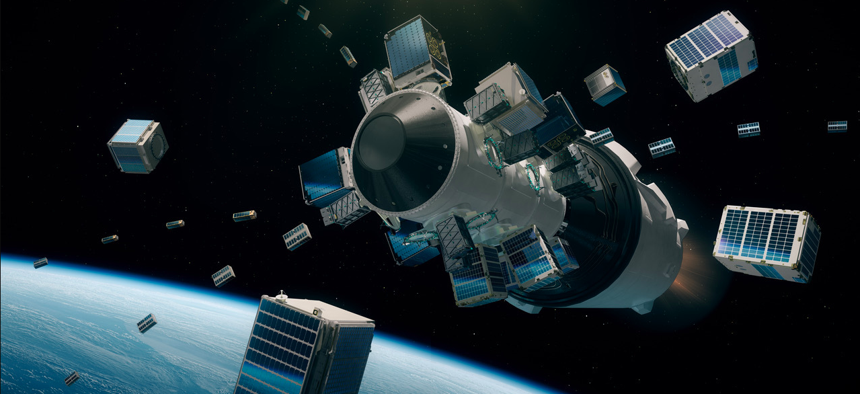
A rendering of rideshare smallsat deployments from Falcon 9 into space via an Exolaunch "Exoport" Exolaunch / www.exolaunch/com
Military Eyes AI, Cloud Computing in Space in a Decade
Physics keeps the Pentagon from orbiting a computer powerful enough for machine learning. So they’re building a network in space.
Machine learning in space may one day revolutionize how the U.S. military tracks enemy forces and moves data around the world. But physics makes training an AI far harder in orbit than on Earth, so that dream is likely a decade away, the director of the Pentagon’s lead satellite agency said Wednesday.
Computers get smaller and more powerful every year, but there are physical limits to what you can do in a small, airtight box, said Derek Tournear, who leads the Space Development Agency.
“On the ground, I can tie myself to a hydroelectric dam and a river to cool my processing center. But in space, you’re always going to be limited by how much heat you can dump and power you can collect,” Tournear said Wednesday during a Defense One webinar.
In order to assemble enough computing power to do machine learning in space, you need to put a lot of small computers in low Earth orbit and then link them up. Over the next two years, a DARPA program called Blackjack will attempt to prove out concepts that could be used to build a self-organizing orbital mesh network.
In four years, Tournear said, he wants to build “masterfully designed” target-recognition algorithms, train them on the ground, and port them to this nascent orbiting network. “So we’re not going to be doing the AI and machine learning in space,” he said. “It’s really got to be done on the ground first and then ported to space where you’re power- and thermal- constrained.”
Perhaps four to six years after that, the orbiting, laser-based communications network will be ready for the hard work. “At that point, you can start to get the computing power to…do some of the machine learning, algorithm development on board [the satellite or spacecraft] in real-time,” he said.
Next year, the Space Development Agency is looking to launch 20 satellites to relay data and eight more to track missiles. By 2024, it wants to launch an additional 150 satellites. This week, the agency put out a broad agency announcement looking for innovative technologies, from encryption to laser communications, to help build those.
More computing power and even machine learning aboard spacecraft would also help the United States keep ahead of emerging threats from Russian or Chinese satellites, said Col. Russell "Russ" Teehan, the portfolio architect for the U.S. Space Force’s Space and Missile Systems Center. “Deep-space domain awareness — that’s where we really don’t have time to phone home, process everything, and then send back a point solution,” Teehan explained during the webinar “So everything [Tournear] mentioned down low, we’re also looking to do up high with deep-space, highly maneuverable, space domain collection assets that are looking to collect that information, have a [communication] architecture up high that’s moving that data around and making decisions and cross cueing to get to that information fast.”
New computer chip architectures, perhaps mimicking the human brain, could accelerate the creation of an orbiting machine-learning network, said Jeff Sheehey, chief engineer of NASA’s Space Technology Mission Directorate. His agency is building processors that are “100 times better” than the radiation-hardened ones that power today’s spacecraft. “We’re also looking at neuromorphic processors,” he said, chips that function less like conventional integrated circuits and more like the synapses of the human brain. More intelligent systems will be necessary if humanity is to build a sustained presence in space, he said. It’s “going to require a lot of assets to be in place that may not have humans tending them for long periods of time. The humans will be there intermittently.”




